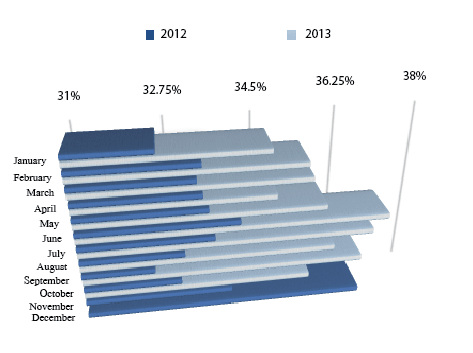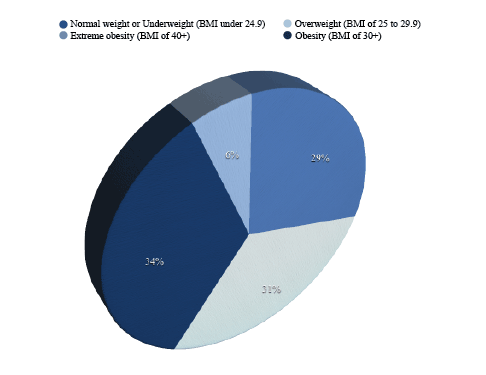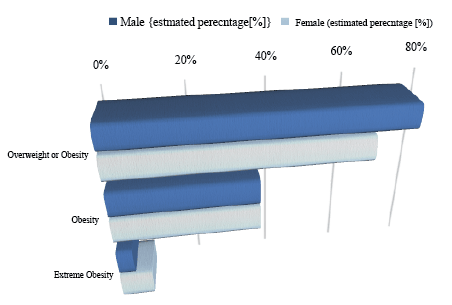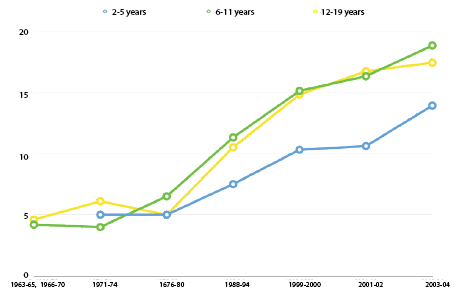
Figure 1: Percentage (%) of US adults who ate unhealthy all day “yesterday” [1]* No data for November and December 2013.

Etetor Roland Eshiet*
Sustainable Energy Environmental and Educational Development (SEEED), Texas, USA*Corresponding author: Etetor Roland Eshiet, Sustainable Energy Environmental and Educational Development (SEEED), 2702 Scarlet Sunset CT, Sugar Land, Texas, USA, E-mail: etetoreshiet@ yahoo.com, etetor.eshiet@see-ed.com
Obesity and weight management are two words that generate controversy in academe, and food and healthcare practice. Although, healthcare practitioners employ lifestyle modification, bariatric surgery and pharmacotherapy as primary weight management programs, these methods may have exacerbating challenges. In many societies around the globe, there appears to be an increase in the use of herbal products in weight management. Tea preparations (infusions, decoctions) are arguably the most prevalent form of administering herbal extracts. The Food and Drug Administration (FDA) considers herbal plants and its supplements foods, not drugs. These foods may provide the much needed alternative resource, and may have biologic benefit in weight management therapy; herbalism may enjoy expanding acceptability and utility by the food and healthcare industry if properly validated, standardized and regulated.
Obesity; Weight management; CAM; Herbalism; Biologic; Antihyperlipidemic; Functional foods
The words “obesity” and “weight management” have experienced a humongous upsurge in popularity and usage post-millennia. Obesity is a topical health concern of millennials (Generation X); media outlets, social and otherwise, are inundated with advertorials, articles, op-eds, and commentaries that introduce, discuss and highlight remediative therapies that may not stand up to the rigorous scrutiny of modern science. Furthermore, obesity is of particular interest to the healthcare and food industry as it maybe representative, nay reflective, of society’s overt, inordinate indulgence in sedentary lifestyles and unwholesome dietary habits. A Gallup-Health way Well-Being Index illustrating the progressively unhealthy dietary habits of adult Americans may lend credence to this assertion (Figure 1) [1]. The World Health Organization (WHO) and the National Institutes for Health (NIH) categorize obesity as the weight status of persons (men, women) with a body mass index (BMI) ≥ 30 kg/m2 (class I obesity [30.0-34.9 kg/m2], class II/class III [≥ 35.0 kg/ m2]; 25.0-29.9 kg/m2 (overweight); 18.5-24.9 kg/m2 (lean) [2]. Healthcare practitioners believe BMI to be the preeminent biomarker, “gold standard,” that indicates elevated propensity for adiposity-related adverse health outcomes. A plethora of major scientific studies indicate that a BMI of 25.0 kg/m2 and above may be a precursor of several non-communicable physiological disorders such as cardiovascular disease (heart, stroke), diabetes, cancer (endometrial, breast, colon), osteoarthritis etc. [3]. These diseases are listed amongst the leading causes of mortality [4]. Trend data obtained from 188 countries suggest that 30% (2.1 billion) of the world’s population may be obese or overweight; in the years 1980-2013, developed and developing countries have shown a significant increase in obesity rates [5,6]. About one-third of adults and one-fifth of children in the US are considered obese (Figures 2-4) [7-9]. More definitive statistical studies reveal that in thirty states of the US, one in three children, age 10-17 years are either overweight or obese. It is believed that the medical expenditure of an obese youngster rises proportionally with BMI and may range from $5,340 to $29,460 over a lifetime. In 2003, the US government expended an estimated $78.5 billion on obesity related health issues. This accounted for about 10% of the national healthcare budget [10]. Research findings suggests that in the United States the annual medical cost of obesity may have increased to $147 billion per year by 2008; obese persons generated medical costs $1,429 more than persons with normal weight [11,12].

Figure 1: Percentage (%) of US adults who ate unhealthy all day “yesterday” [1]* No data for November and December 2013.

Figure 2: Overweight and obesity among US adults ages 20 and older 2009-2010 [7].

Figure 3: Distribution by sex (estimated percentage) of overweight and obesity among US adults age 20 and older 2009-2010 [7].

Figure 4: Prevalence of overweight among children and adolescents
age 2-19 years, 1963-2004.
*
Excludes pregnant women stating with 1971-74. Pregnancy status not
available for 1963-65 and 1966-70.
**Data for 1963-65 are for children 6-11 years of age; data for 1966-70
are for adolescents 12-17 years of age, not 12-19 years [8].
As the socio-economic burden of obesity becomes increasingly evident, it is imperative that more concerted effort is made to attenuate this largely preventable disorder. Presently, frequently used weight management programs involve lifestyle modification, bariatric surgery and pharmacotherapy. Lifestyle modification includes performing the 4 major positive lifestyle behaviors (PLBs): a) consuming fruits and vegetables daily; b) non-smoking; c) drinking moderately and; d) exercising actively. These have been determined to positively impact health. A 2007 SLAN (survey of lifestyles, attitudes and nutrition) study demonstrated that there may be a 14-year disparity in total mortality between persons (men, women) who practice all 4 PLBs and those who fail to do so [13]. A 2003- 2012 systematic review and meta-analysis of 164 studies (37 randomized controlled trials (RCT), 127 observational) examining the effectiveness and risk of bariatric surgery showed that though sustained, substantial weight loss could be achieved, exposure to complications, re-operation and death are significant concerns [14]. Whereas a number of pharmacological agents such as oralistat, sibutramine, metformin and acarbose have exhibited efficacy and safety profiles in RCT and may be employed as drugs of choice for adjunct pharmacotherapy in obese subjects, several others i.e. sulphonylurea and insulin treatment may evoke significant weight gain [15,16]. Therefore, it becomes prudent to reiterate that though it is evident that the practice of lifestyle modification, bariatric surgery and pharmacotherapy has interminable advantages, these practices may also have staggering adverse effects and constraints [17].
While there may be several techniques used in combating obesity, this paper focuses primarily on methodologies employed by complementary and alternative medicine (CAM) practitioners, particularly herbalism. The utilization of herbal products in disease therapy dates back to early man and remains unabated today [18-20]. Although a host of herbal remedies are used to assuage the health consequences and comorbidities of obesity, several exist that may possess biologic benefit in weight management. The plurality of people in underdeveloped and developing countries use herbal products as alternative medicine due to the enormous cost of modern medicine; ≥ 80% of the world population use herbal medicine as primary health care [21,22]. About 38% of adults and 12% of children use CAM in the US; 17.7% of adults prefer natural (herbal) products [23,24].
A number of clinical studies have been performed to examine the effectiveness of certain herbal preparations in weight management therapy. Primary indicators employed in weight loss determination include reduction in circumference (WC (Waist Circumference) [body girth at the level of the abdomen]) and body weight (BW). A recent study exploring the clinical efficacy and tolerability of a unique herbal preparation (comprising the extracts of Sphaeranthus indicus and Garcina mangostana) for weight management revealed statistically significant reductions in waist (11.9 cm; P<0.0001), hip circumferences (6.3 cm; P=0.0001), BMI (2.2 kg.m2; P<0.0001) and BW (5.2 kg; P<0.0001) at study conclusion (8 weeks, n=100). This herbal formula was shown to be effective and well-tolerated; minor adverse effects were evenly distributed [17]. Further in vivo, in vitro and clinical investigative studies have been performed to demonstrate the efficacy of S. indicus and G. mangostana in disease therapy, singularly and in combination. Pharmacological reports validate the therapeutic value of S. indicus and suggest that it may exhibit renoprotective, neuroleptic, anxiolytic, antihyperglycemic, bronchodilatory, anti-inflammatory, immunomodulatory, larycidal, anxiolytic, and antihyperlipidemic properties [25,26]. Results obtained from studies performed on G. mangostana are indicative of antiviral, anti-inflammatory, antioxidant, antiallergic, antibacterial and antitumoral activity [27,28]. Another study evaluating the efficacy and safety of a Chinese herbal medicine formula (RCM-104) in the management of simple obesity showed that RCM-104 may be well tolerated and beneficial in reducing BW and BMI in humans. Differences in BW and BMI between treatment and control group were significant (p<0.05); adverse effects were minor in both groups. The herbal materials that constitute RCM-104 include: 1) Camellia sinensis (Lu Cha ye: 40%); 2) Cassia obtusifolia (Jue Ming Zi: 40%) and; 3) Sophora japonica (Huai Hua: 20%) [29]. Furthermore, the herbal formulation L185008F (Adipromin) comprised of aerial extracts of: 4) Moringa olefera; 5) Murrya koenigii ; 6) Curcuma longa rhizomes, (6:3:1), exhibited dual utility in combating weight loss and controlling blood glucose levels. Human subjects (2 groups: placebo [n=25]; L185008F [n=25]) that took the herbal preparation showed reduced triglycerides, fasting blood glucose, low-density lipoprotein (LDL) and LDL/HDL (high-density lipoprotein) ratio. An increase in serum adiponectin level (21.26% [P=0.012]) was observed in the treatment group when compared with the control group [30]. Sphaeranthus indicus, Garcina mangostana and plants 1-6 are amongst several believed to possess antihyperlipidemic potential with demonstrable weight loss proficiency and minor adverse effects [31-34].
As researchers explore complementary remedies in the treatment of obesity and other disorders, there appears to be an emerging interest in the possible therapeutic activity of functional foods. Functional foods can simply be characterized as “foods that have a potentially positive effect on health beyond basic nutrition”. A more elaborate definition lists functional foods as wholesome, enhanced (enriched) foods that offer health benefits outside the bare essential nutrients, when taken in definite quantities in a diverse but regular diet [35]. Scientific observations made from studies using functional foods support the hypothesis that the bioactive components of certain foods possess optimal physiological, psychological and albeit antihyperlipidemic ability. Functional foods include but are not limited to fruits, vegetables, soya, whole grains and milk.
Recent studies by Panda et al., [36-40] investigating the efficacy of certain functional food derivatives highlight the particular healing capabilities of sweet potato wine, sweet potato beer, sapota wine and bael wine. Sweet potato is believed to lower potential health risks associated with heavy metals and oxygen radicals, and possesses anti-oxidative, antiinflammatory properties. Prior research on sweet potato has focused on the resin glycosides, batatins (i.e. batatin I, batatin II). However, the novel discovery of a group of glycosides, batatosides (i.e. batatoside III, batatoside IV, betatoside V) in sweet potato may present its further healing potential [41]. Achras sapota Linn (Sapota) which contains tannins, dietary fiber and large amounts of vitamins A, B and C is believed to have antibacterial, antiparasitic and antiviral properties. Aegle marmelos Linn (Bael) has been studied for its lipolytic effect; quantitatively analyzed components and dichloromethane (DCM) extracts of the aerial parts of A. marmelos have exhibited the ability to counteract obesity [42].
Herbal teas may also act as health promoting beverages and bioactive functional foods particularly when it pertains to the prevention of metabolic syndromes (obesity, diabetes, hypertension, dyslipidemia) and cardiovascular diseases [43]. Brickellia cavanillesii (Asteraceae), native to Neotropical Americas, commonly consumed as a beverage (infusion, decoction) for its presumed ameliorative properties (antidiabetic, antioxidative.) falls easily into this category of foods. Scientific quantitative, qualitative, proteomic and genomic investigations into the efficacy of B. cavanillesii, and other members of the Brickellia genus, demonstrate the potential of certain members of the Asteraceae family as therapeutic agents [18-20, 44-47]. Moreover, a plethora of scientific data exists that illustrate the extensive use of the herbal tea preparations of several plants, and other categories of food, as functional foods [48]. Consequently, there is a dire need to critically investigate the utility of incorporating functional foods in preventative health (obesity) and weight management (loss) programs.
Herbal products are inexpensive, readily available, well-tolerated in isolation, and perhaps not subjected to the strenuous Food and Drug Administration (FDA) regulations otherwise ascribed to pharmaceuticals [49,50]. This makes it an excellent first-line treatment for uncomplicated obesity. Herbal preparations constitute a tremendous resource for alternative remedy particularly at disease onset. Conversely, herbal plant ameliorative therapy elicits a fusillade of troubling concerns. Potential drug interactions and side effects are key mitigating factors. Herbal plant identification, variability, contamination and standardization are critical concerns of herbalism. Therefore, studies to assure the efficacy, quality and safety of plants employed in therapy must be undertaken. The lyophilization of plant extracts typically ensures that data sets obtained are measurable, verifiable, and reproducible [51]. Furthermore, exploratory clinical studies investigating a multiplicity of biomarkers may provide the much needed resource for determining the biologic benefit of herbal products in the weight management of overweight and obese persons.
The author wishes to thank Dr. Kenneth I. Eshiet, Messrs. Derec Moore and Emmanuel Ben-Edet; and Ms. Maureen Saduwa for reviewing the manuscript (the persons mentioned above are of Sustainable Energy Environmental and Educational Development (SEEED), UK & US.
Download Provisional PDF Here
Article Type: Commentary
Citation: Eshiet ER (2016) Obesity and Weight Management: The Efficacy of Herbal Products as Therapeutic Agents. Nutr Food Technol 2(3): doi http://dx.doi.org/10.16966/2470-6086.122
Copyright: © 2016 Eshiet ER. This is an openaccess article distributed under the terms of the Creative Commons Attribution License, which permits unrestricted use, distribution, and reproduction in any medium, provided the original author and source are credited.
Publication history:
All Sci Forschen Journals are Open Access